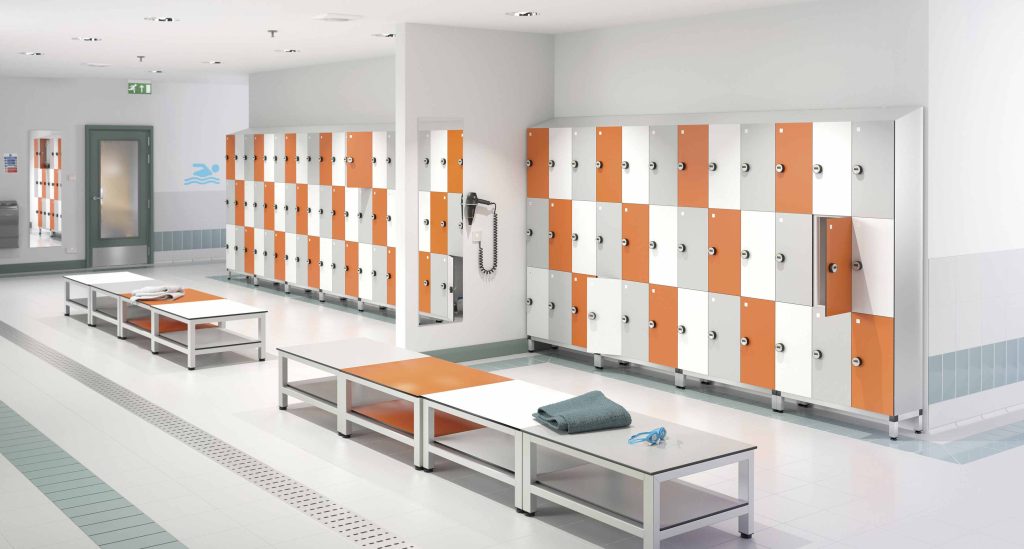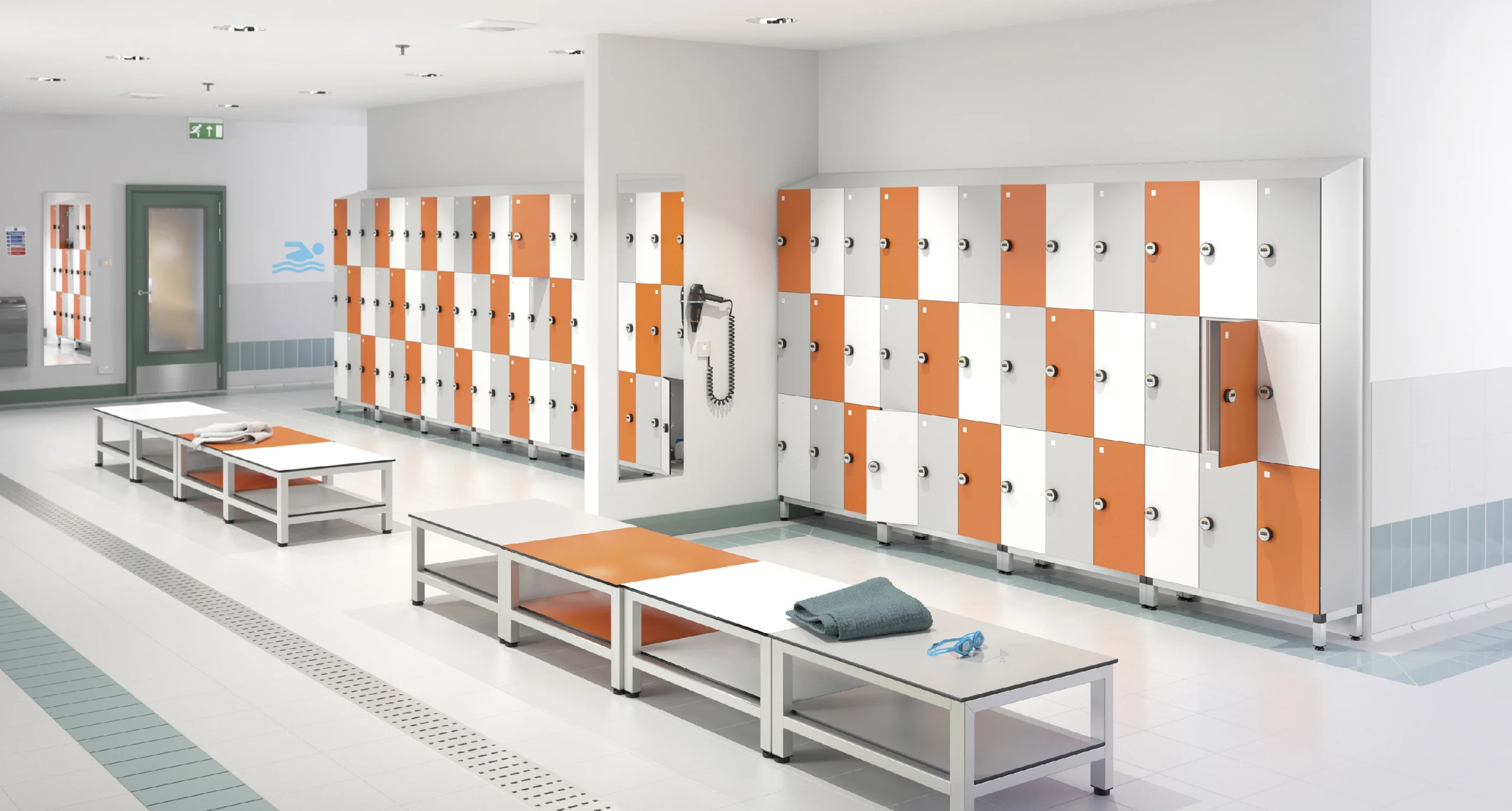Wet-area lockers are some of the toughest lockers to design and build. Every day they face humidity, moisture, cleaning chemicals, and thousands of users. Yet, when planned correctly, they can remain attractive, secure, and hygienic for many years.
This guide explains how to plan, specify, and maintain locker systems for swimming pools, spas, and aquatic centres — with practical insight from Total Locker Service:
https://total-locker-service.com

Why Wet-Area Lockers Are a Special Challenge
In pools and spas, moisture is constant. Steam, splashes, and condensation create a perfect storm for corrosion and decay. Materials expand and contract, locks seize, and hinges rust. Poorly designed lockers soon smell of mildew and lose visual appeal.
However, modern wet-area locker systems can solve these issues. By using corrosion-proof materials, sealed edges, and smart ventilation, facility managers can deliver storage that remains fresh and secure even in extreme humidity.
wet-area lockers. Key Requirements: Moisture, Corrosion & Hygiene
To withstand moisture and chemical exposure, lockers must combine resilience and easy cleaning. Choosing the right materials is essential.
Material Choices
- Compact Grade Laminate (CGL): Dense and waterproof, ideal for pool environments. It resists swelling and delamination, even with constant splashing.
- Plastic (HDPE or Polypropylene): Fully waterproof and rust-free. These lockers are light, colourful, and easy to clean.
- Aluminium: Lightweight and corrosion-resistant. Commonly used for locker frames and hinges.
- Stainless Steel: Very durable and suitable for hardware or reinforcement. Grade 316 steel performs best in chlorinated air.
- Phenolic Resin: A premium option with high density and exceptional moisture resistance, often used for door panels or cubicle partitions.
Hybrid designs are popular. For example, an aluminium frame with laminate doors offers both strength and style.
Ventilation, Drainage & Mould Prevention
Locker interiors must breathe. Ventilation slots at the top and base allow air to circulate and speed up drying. Sloped tops help water drain away, and stainless bases lift lockers above puddles. A design that prevents stagnant moisture is essential to stop mould and odour.
Security in Wet Areas: Locking, Access & Durability
Lock choice affects usability, longevity, and user confidence. Moisture makes cheap locks corrode or jam quickly, so invest in proven systems.
- Padlock Hasp: Simple and effective. Users supply their own padlock. Stainless steel versions are best for wet zones.
- Mechanical Key Locks: Should use sealed housings or brass components. Reliable when maintained correctly.
- Combination Locks: Good for staff lockers. Choose corrosion-proof dials or rubber-sealed keypads.
- Electronic or RFID Locks: Offer keyless convenience. Select IP-rated locks that resist water ingress. Battery change access must be easy and secure.
Whichever system you use, all screws, hinges, and cam locks should be stainless steel or anodised aluminium. Avoid mild steel components at all costs.
Layout & Space Planning in Changing Rooms
Layout strongly affects hygiene and traffic flow. A well-planned locker area improves both comfort and maintenance efficiency.
Locker Dimensions & Accessibility
Users come in all sizes, so include lockers at varying heights. Combine small compartments for valuables with tall lockers for coats or sports bags. Ensure at least one bank of accessible lockers complies with disability access standards. Keep clear aisles wide enough for wheelchairs and cleaning trolleys.
Zoning Wet & Dry Areas
Separate “wet” from “dry” zones wherever possible. Lockers positioned directly beside showers or pool entrances face intense moisture. By moving them a few metres away and using anti-slip flooring, you extend their life and reduce cleaning effort.
Modular Configurations
Modular locker banks allow flexible planning. You can start with a small number and expand as visitor numbers grow. This also simplifies future maintenance — single modules can be removed or upgraded without dismantling entire rows.
Integration with Changing Room Furnishings
Lockers must blend with benches, cubicles, and seating areas. A coherent design looks professional and aids hygiene control.
Benches & Seating
Choose benches with plastic or hardwood slats over stainless-steel frames. Avoid untreated timber in wet rooms; it absorbs water and rots. Position benches so water drains away from locker doors and locks.
Hooks, Shelving & Accessories
Provide plenty of hooks for towels and bags. Stainless-steel or coated aluminium accessories are best. Integrated hanging rails inside lockers help users keep gear off wet floors.
wet-area lockers. Maintenance, Cleaning & Lifecycle Management
Wet-area lockers demand routine maintenance. A clear schedule prevents major repairs and keeps the facility fresh.
Cleaning Protocols
- Use mild, non-acidic cleaners suitable for laminate or plastic.
- Rinse thoroughly to remove disinfectant residue.
- Inspect weekly for signs of rust, mould, or delamination.
- Ensure staff know which chemicals are safe for each surface.
Daily wipe-downs of doors and handles prevent grime build-up. Quarterly deep cleans keep interiors hygienic.
Replacement Parts & Repairs
Design lockers for modular repair. Hinges, locks, and doors should be replaceable individually. Maintain a small parts stock to avoid downtime. Total Locker Service offers spares and refurbishment options to extend system life:
https://total-locker-service.com
Case Example: Community Pool Upgrade
A community swimming pool in the Midlands replaced rusting steel lockers with new compact laminate models. The new units used stainless hinges and ventilation slots to encourage drying. Doors featured waterproof electronic code locks.
Within six months, maintenance calls dropped by 80 percent, and customer satisfaction rose sharply. Energy costs also reduced because lockers no longer trapped damp air.
This example shows how material selection, airflow, and proper lock choice can transform locker reliability.
Costing, ROI & Risk Reduction
Investing in quality wet-area lockers saves money long-term. Lower maintenance and replacement costs often offset the initial price premium within a few years.
Key Cost Drivers
- Material type — laminate and plastic cost more than mild steel but last longer.
- Locking system — electronic locks increase cost but improve security.
- Installation — waterproof sealing, drainage and floor levelling add labour.
- Maintenance — regular inspections prevent major failures.
When evaluating suppliers, consider total cost of ownership, not just purchase price. A durable locker system typically lasts 10–15 years with minimal upkeep.
Wet-area lockers.Compliance, Health & Safety
Locker areas must meet hygiene and safety regulations. All materials should be non-porous and easy to disinfect. Floors should drain well to avoid puddles and slips. Lockers should never block fire exits or ventilation grilles.
If you use electronic locks or smart access, comply with data protection rules such as GDPR to protect user information. Display clear signage explaining locker use and any liability limitations.
Implementation Roadmap
To deliver a successful wet-area locker project, follow a logical sequence.
- Site Assessment: Measure humidity, water sources, drainage and existing layouts.
- Specification: Choose materials, colours, and lock types suited to local conditions.
- Design Layout: Separate wet and dry areas; plan electrical points if using electronic locks.
- Supplier Selection: Partner with experts in wet-area locker systems, such as Total Locker Service.
- Installation: Ensure floors are level, surfaces sealed, and ventilation maintained.
- Training: Educate cleaning staff on suitable products and procedures.
- Maintenance Schedule: Document inspections and track any part replacements.
Following these steps reduces risk, saves cost, and ensures smooth operation from day one.
Best Practices for Long-Term Reliability
- Choose IP-rated locks or fully mechanical systems for splash zones.
- Specify stainless fixings even for hidden components.
- Add drainage channels or raised plinths beneath locker banks.
- Use gentle cleaning agents to protect finishes.
- Record maintenance activity and review annually.
Small preventative actions extend locker lifespan dramatically. When repairs are needed, act quickly before damage spreads.
Design Aesthetics & Branding
Lockers contribute strongly to first impressions. Choose colours that reflect your brand and create calm, fresh environments. Blue, aqua, and light grey tones suit aquatic themes. Laminates can include digital prints or custom signage.
Total Locker Service can supply lockers with branded doors or etched numbering for a professional look.
https://total-locker-service.com
Environmental & Sustainability Considerations
Modern materials are more sustainable than ever. Compact laminate uses certified timber fibres, and aluminium frames are fully recyclable. Long product life means less waste. Specify suppliers who minimise packaging and transport emissions. Sustainability isn’t just ethical; it’s also good marketing for leisure facilities seeking eco-credentials.
User Experience Matters
Beyond durability, focus on how people interact with lockers. Doors should open smoothly, locks should be intuitive, and compartments should feel clean. Clear signage, good lighting, and visible staff assistance all encourage users to respect facilities.
Happy customers leave positive reviews and return often.
Digital & Smart Locker Options
For high-end spas or premium gyms, smart lockers add extra value. Users can reserve a locker via app, unlock it with RFID wristbands, and receive automatic reminders to collect items. These systems integrate with membership databases and reduce staff workload. Waterproof electronics now make smart lockers viable even in humid environments.
Training & Staff Involvement
Front-line staff play a big role in keeping locker areas running well. Train them to identify early warning signs — loose hinges, sticky locks, worn seals. Encourage prompt reporting and empower them to perform minor fixes where safe. Their feedback is vital to improving layout and maintenance cycles.
Refurbishment & Retrofit Options
Not every project requires full replacement. In many cases, existing steel lockers can be upgraded with new laminate doors, stainless hinges, and waterproof locks. This approach reduces waste and keeps costs low.
Total Locker Service offers retrofit programmes to modernise locker banks while the facility stays open:
https://total-locker-service.com
Conclusion
Designing lockers for wet areas requires care, but the rewards are lasting. With durable materials, corrosion-proof locks, good ventilation, and regular maintenance, your changing rooms will stay clean, secure, and welcoming.
Visitors notice the difference, and facility teams enjoy lower running costs.
For expert help specifying wet-area locker systems, benches, and cubicles, contact Total Locker Service at:
https://total-locker-service.com
Their experience across schools, leisure centres, and spas ensures you receive advice tailored to your environment. Invest once — and enjoy dependable performance for years to come.
